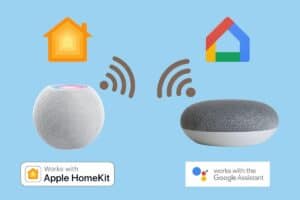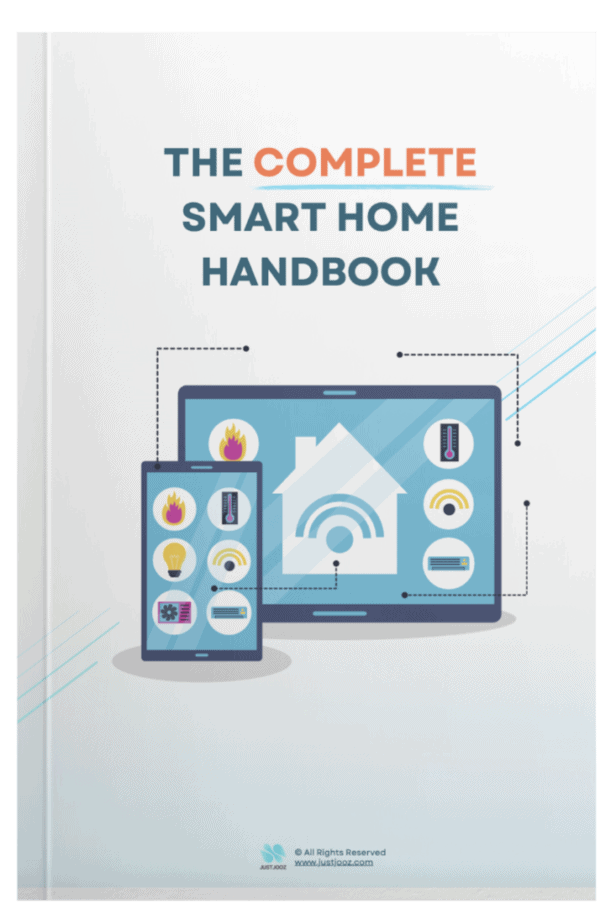Smart Home Design: 14 Ideas to Start with Home Automation
We’re reader-supported; we may earn a commission from links in this article.
In today’s fast-paced world, smart home technology has transformed how we interact with our living spaces.
A well-designed smart home can make life more convenient, efficient, and enjoyable for the whole family. From automated lighting to intelligent security systems, countless possibilities exist.
In this article, we’ll delve into the exciting world of smart home design, providing insights, tips, and inspiration to create an automated home design.
Let’s get into it!
1. Smart Home Technology
a. What Is Smart Home Technology?
At its core, smart home technology refers to a network of devices and systems that are interconnected and capable of automation, remote control, and intelligent decision-making.
These devices, often called “smart devices,” communicate with each other and with you through the internet, enabling you to control various aspects of your home using your smartphone, voice commands, or even automated routines.
b. Benefits of Smart Homes
The benefits of adopting a smart home design are far-reaching and multifaceted.
The advantages are evident in every corner of your living space, from enhanced convenience and energy efficiency to improved security and entertainment. Smart homes empower you to streamline your daily tasks, save time, and gain greater control over your environment.
2. Creating a Family-Centric Smart Home
a. Identifying Family Needs
When planning a smart home for your family, the first step is identifying each family member’s specific needs and preferences.
Consider the routines, hobbies, and requirements of everyone in your household.
Do you have young children who need interactive learning spaces?
Are there elderly family members who require health monitoring and assistance?
Understanding these unique needs allows you to tailor your smart home to cater to everyone.
b. Integration and Compatibility
The key to a successful smart home is integrating various devices and systems seamlessly.
Compatibility is crucial, as different smart devices often operate on different platforms.
Opt for devices that can be easily connected and controlled through a centralized hub or app.
This ensures that all family members can access and manage the smart features of the home without confusion or technical hurdles.
3. The Heart of the Home: Smart Kitchen
a. Smart Appliances and Cooking Aids
The kitchen is where culinary creativity comes to life, and intelligent technology elevates this experience to new heights.
Imagine using voice commands to preheat your oven, control cooking times, and receive recipe suggestions based on the ingredients you have. Smart refrigerators can even keep track of food expiration dates and create shopping lists for you.
b. Meal Planning and Grocery Management
With busy family schedules, meal planning can be a daunting task.
Smart home technology comes to the rescue with meal-planning apps that suggest recipes, generate shopping lists, and even place online grocery orders. This ensures you always have the necessary ingredients, making dinnertime a breeze.
4. Comfort and Entertainment: Living Room Innovations
a. Voice-Activated Entertainment Systems
Gone are the days of searching for remote controls or struggling with complicated interfaces. Voice-activated entertainment systems allow you to control your TV, music, and lighting using simple voice commands. This level of convenience transforms your living room into a hub of relaxation and enjoyment.
b. Intelligent Furniture and Layouts
Smart home design goes beyond gadgets; it extends to furniture and layout choices that enhance comfort and functionality.
Imagine couches that adjust their firmness based on individual preferences or coffee tables that double as wireless charging stations. These innovative additions create a living room that caters to your family’s unique needs.
5. Bedrooms of the Future
a. Personalized Sleep Environments
Sleep is vital to our overall well-being, and smart home technology can optimize your sleep environment.
Smart mattresses adjust firmness, temperature, and even elevation to provide the perfect night’s sleep. Bedtime routines can be enhanced with calming lighting and soothing music, promoting restful slumber.
b. Smart Closets and Wardrobes
Getting dressed in the morning becomes a breeze with smart closets that suggest outfits based on the weather and your schedule.
RFID technology can help keep track of your wardrobe and alert you if you’re missing essential items. This feature is especially helpful for busy families with multiple clothing preferences.
6. Smart Bathrooms for All Ages
a. Automated Water Temperature Control
Families with young children or elderly members can benefit from automated water temperature control in the bathroom.
No more worries about scalding water or uncomfortable temperatures. Smart faucets and showers ensure a safe and pleasant bathing experience for everyone.
b. Health and Wellness Monitoring
The bathroom is also a space where health and wellness routines take place. Smart mirrors can track changes in your appearance over time, while smart scales provide insights into your body composition. These features empower family members to monitor their health journey conveniently.
7. Security and Peace of Mind
a. Smart Locks and Entry Systems
Security is a top priority for any family, and smart home technology offers advanced solutions. Smart locks allow you to lock and unlock your doors remotely, grant temporary access to guests, and receive alerts when someone enters or exits your home. This level of control enhances both security and convenience.
b. 24/7 Surveillance and Alerts
Smart home security systems provide continuous surveillance and real-time alerts for added peace of mind. Whether you’re at home or away, you can monitor your property, receive notifications of suspicious activities, and even communicate with visitors through smart doorbells.
As the project unfolds, it’s vital to consider the smart home’s compatibility with the existing infrastructure. Smart home technology works seamlessly when they are seamlessly integrated into the house’s systems, ensuring a smooth transition from traditional living to a technologically advanced lifestyle.
8. Energy Efficiency and Sustainability
a. Smart Thermostats and Energy Monitoring
Reducing energy consumption not only benefits the environment but also saves you money. Smart thermostats learn your temperature preferences and adjust heating and cooling accordingly.
Energy monitoring systems track your usage patterns, offering insights into where you can make energy-saving improvements.
b. Reducing Environmental Footprint
Smart homes can contribute to a greener future by promoting eco-friendly practices. Automated lighting systems adjust brightness based on natural light, and smart appliances can operate during off-peak hours to lower energy consumption. These small adjustments collectively make a significant impact on reducing your home’s environmental footprint.
9. Designing a Home Office for Work-Life Balance
a. Ergonomic Furniture and Lighting
As remote work becomes increasingly common, a home office that promotes productivity and well-being is essential. Invest in ergonomic furniture that supports proper posture and reduces strain. Adjustable standing desks, supportive chairs, and optimal lighting create a workspace that inspires focus and creativity.
When delving into the practical implementation of a smart home, a detailed guide is essential. Homeowners can embark on this journey by selecting the right smart home products that align with their needs and preferences.
Each choice contributes to a cohesive smart home ecosystem, from smart lighting systems that adapt to various moods and tasks to smart thermostats that optimize energy consumption.
b. Digital Assistants for Productivity
Digital assistants like voice-activated speakers can streamline tasks and keep you organized throughout the workday. They can manage your calendar, set reminders, and answer questions, allowing you to stay on top of your professional responsibilities while balancing family life.
10. Child-Friendly Smart Spaces
a. Interactive Learning and Play Areas
Smart home technology has the potential to revolutionize how children learn and play. Interactive learning apps, augmented reality games, and educational videos can seamlessly integrate into designated play spaces. These immersive experiences make learning enjoyable and engaging for young minds.
b. Parental Controls and Safety Features
Parental controls ensure children can access age-appropriate content while browsing the internet or using smart devices. In addition, smart cameras and sensors can monitor children’s activities and alert parents if any safety concerns arise, providing peace of mind even when you’re not in the same room.
11. Elderly-Friendly Living
a. Fall Detection and Emergency Response
For families with elderly members, smart home technology offers valuable safety features. If a fall occurs, fall detection sensors can send alerts to family members or emergency services. Wearable devices with panic buttons provide a quick way for seniors to call for help in an emergency.
b. Medication Reminders and Health Tracking
Managing medications and health routines becomes more manageable with smart reminders and tracking systems. Smart pill dispensers can dispense medications at designated times, and health monitoring devices track vital signs, ensuring that elderly family members receive the care they need.
12. Customizing Your Smart Home Experience
a. Personalizing Automation Settings
One of the remarkable aspects of smart home technology is its adaptability. Each family member can customize their automation preferences based on their daily routines and preferences. From adjusting lighting and temperature to controlling entertainment systems, personalization enhances the overall smart home experience.
b. Adapting to Changing Family Dynamics
As families grow and evolve, so do their needs and routines. Smart homes can easily adapt to changing dynamics by allowing you to modify automation routines, update user profiles, and incorporate new devices. This flexibility ensures that your smart home remains relevant and beneficial for years.
13. Overcoming Challenges and Concerns
a. Privacy and Data Security
While smart homes offer countless benefits, concerns about privacy and data security are valid. It’s essential to choose reputable brands that prioritize data protection. Regularly update passwords, review privacy settings, and educate family members about safeguarding personal information.
b. Technology Education for All Ages
To fully maximize the potential of a smart home, all family members need to understand how to use and interact with the technology. Take the time to educate children, elderly relatives, and even yourself about the features and functions of each device. This knowledge empowers everyone to make the most of the smart home experience.
The journey begins with understanding the core components of smart home systems. These systems encompass an array of smart devices, such as smart lighting systems and smart thermostats, that work harmoniously to enhance the functionality and efficiency of a house.
The foundation of a smart home network lies in the integration of these devices, facilitated by a smart home hub. This central hub orchestrates the communication between various devices, allowing users to control and monitor their smart home elements effortlessly.
14. Embracing the Future of Home Living
In conclusion, the concept of a smart home transcends mere convenience; it promises a lifestyle that revolves around individual needs, seamless automation, and unparalleled comfort.
By embracing smart home technology, you’re creating a living space that caters to your family’s present needs and investing in a future that embraces innovation and the limitless possibilities of technological advancement.
FAQs (Frequently Asked Questions)
Q: How can I ensure that my smart home remains secure and protects my family’s privacy?
Smart home security begins with selecting reputable devices from trusted brands. Regularly update passwords, enable two-factor authentication, and review privacy settings. Educate your family about online safety practices to minimize risks.
Q: Are there any potential downsides to incorporating too much smart technology into our home?
While smart technology offers numerous benefits, overdependence can lead to technological burnout or decreased face-to-face interaction. Balance is key; choose technologies that enhance your lifestyle without compromising meaningful human connections.
Q: What if I’m not tech-savvy? Can I still enjoy the benefits of a smart home?
Absolutely! Many smart devices are designed with user-friendly interfaces and intuitive apps. Start with devices that align with your immediate needs, and gradually explore more advanced features as you become more comfortable with the technology.
Q: How do I manage the costs of transitioning to a smart home?
Creating a smart home doesn’t have to be an all-or-nothing endeavor. Begin by prioritizing areas where automation would have the most significant impact, such as security or energy efficiency. As your budget allows, gradually expand your smart home ecosystem.
Q: Will my smart home become obsolete as technology advances?
While technology evolves rapidly, many smart devices are designed to be compatible with future updates and innovations. Opt for devices that offer regular firmware updates and check for compatibility with upcoming smart home standards. This ensures that your smart home remains relevant over time.
Final words
A smart home can be a great way to make your life easier and more convenient, and it can also be a lot of fun for the whole family. When designing a smart home, it is important to consider all your family members’ needs.
Once you have a good understanding of your needs, you can start to choose the right smart home devices and systems. Many options are available, so you should be able to find something that fits your budget and lifestyle.
A crucial aspect of incorporating smart home technology into architectural projects is meticulous planning. Integrating smart devices seamlessly into the design of a building requires a strategic approach.
Architects and designers must envision how these devices will blend with the house’s aesthetics while elevating functionality. This requires a deep understanding of the project and a well-thought-out smart home strategy.

Justin Chia
Justin is the author of Justjooz and is a data analyst and AI expert. He is also a Nanyang Technological University (NTU) alumni, majoring in Biological Sciences.
He regularly posts AI and analytics content on LinkedIn, and writes a weekly newsletter, The Juicer, on AI, analytics, tech, and personal development.
To unwind, Justin enjoys gaming and reading.





